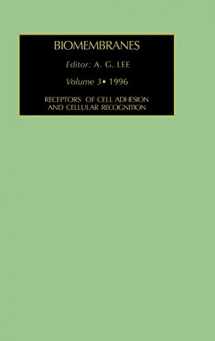
Receptors of Cell Adhesion and Cellular Recognition (Volume 3) (Biomembranes. A Multi-Volume Treatise, Volume 3)
ISBN-13:
9781559386609
ISBN-10:
1559386606
Edition:
1
Author:
A.G. Lee
Publication date:
1996
Publisher:
Elsevier Science
Format:
Hardcover
319 pages
FREE US shipping
on ALL non-marketplace orders
Marketplace
from $48.50
USD
Marketplace offers
Seller
Condition
Note
Seller
Condition
Used - Like New
Book details
ISBN-13:
9781559386609
ISBN-10:
1559386606
Edition:
1
Author:
A.G. Lee
Publication date:
1996
Publisher:
Elsevier Science
Format:
Hardcover
319 pages
Summary
Receptors of Cell Adhesion and Cellular Recognition (Volume 3) (Biomembranes. A Multi-Volume Treatise, Volume 3) (ISBN-13: 9781559386609 and ISBN-10: 1559386606), written by authors
A.G. Lee, was published by Elsevier Science in 1996.
With an overall rating of 3.7 stars, it's a notable title among other
books. You can easily purchase or rent Receptors of Cell Adhesion and Cellular Recognition (Volume 3) (Biomembranes. A Multi-Volume Treatise, Volume 3) (Hardcover) from BooksRun,
along with many other new and used
books
and textbooks.
And, if you're looking to sell your copy, our current buyback offer is $0.3.
Description
Volume 3 of Biomembranes covers receptors of cell adhesion and cellular recognition. Proteins in the plasma membrane of cells are heavily involved in processes of cell adhesion, but such proteins were not actually isolated and characterized until the mid-1970s. Since then, application of the methods of molecular biology has led to the recognition of four major classes of cell adhesion molecule (CAMs), the immunoglobulin super family, the cadherins, the integrins, and the selecting. A convenient system in which to study the importance of cell adhesion is in blood platelets where aggregation eventually leads to thrombus formation in a process involving a range of surface glycoproteins. Interaction with the extracellular matrix is exemplified by CD44, the receptor for hyaluronan, and a complex carbohydrate that is a major component of the extracellular matrix surrounding migrating and proliferating cells. Membrane-associated mucins have a variety of effects on cell adhesion. The super family of immunoglobulin related proteins also include the T cell receptors and the major histocompatibility complex (MHC), which, together with the receptors for immunoglobulins (the Fc receptors), are of fundamental importance in the processes of immunity. Volume 3 of Biomembranes explores the structures and functions of the molecules involved in these important functions of the cell.


We would LOVE it if you could help us and other readers by reviewing the book
Book review

Congratulations! We have received your book review.
{user}
{createdAt}
by {truncated_author}


